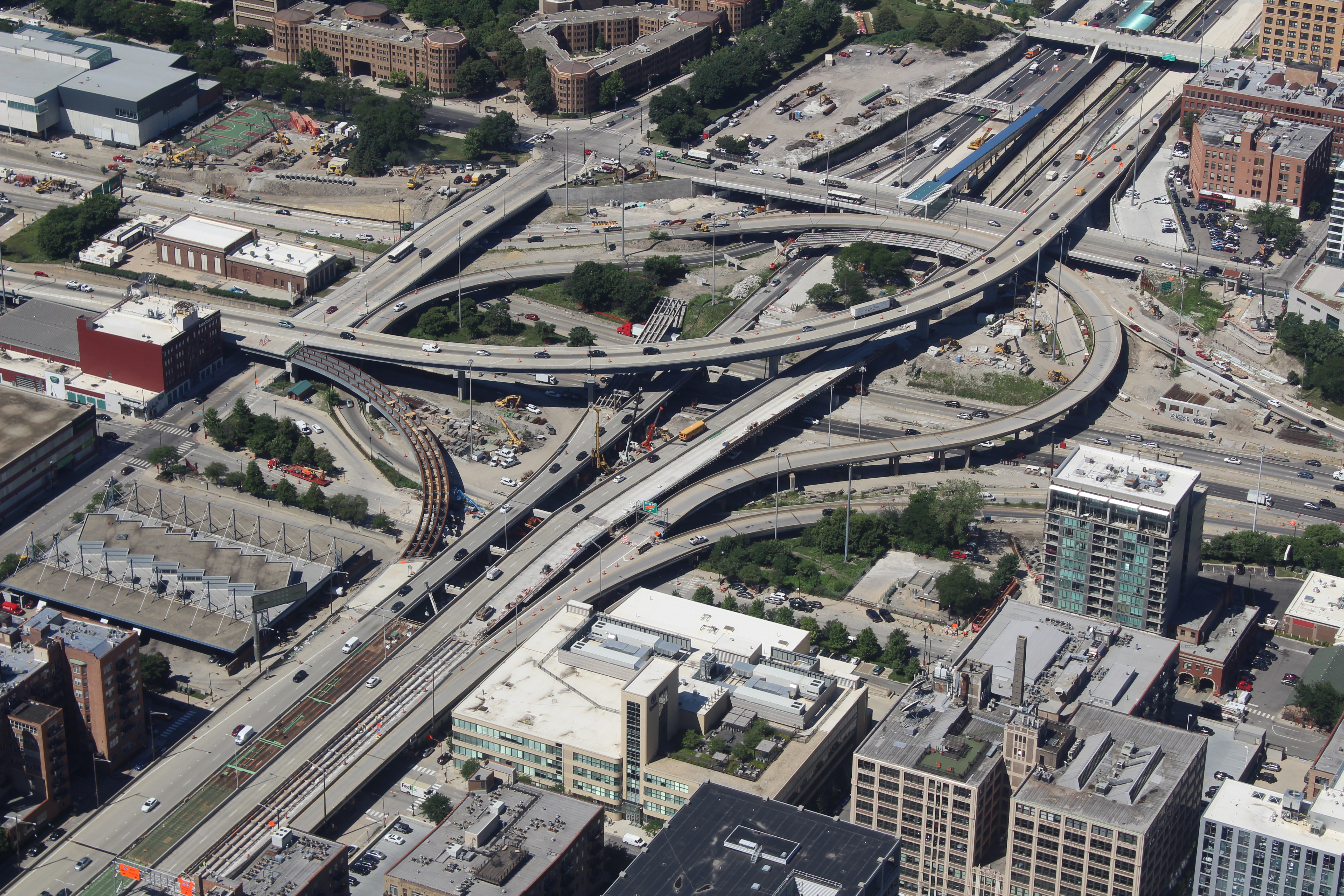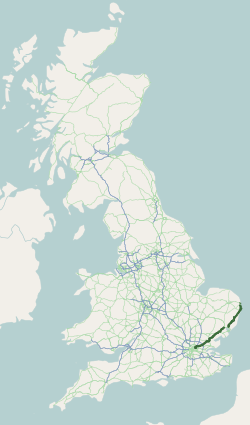|
M15 Motorway (Great Britain)
The M15 motorway was the designation planned in the late 1960s and early 1970s for use on the North Circular Road (A406) after it had been upgraded to motorway standard. The upgrade was part of the London Ringways Plan to build motorways throughout London to ease congestion in the central area. Under the Ringways Plan, the North Circular Road was the northern section of Ringway 2. Most of the Ringways Plan was cancelled in 1973 and the upgrade of the A406 took place in a piecemeal fashion during the following three decades. Although much of the road is now grade-separated dual carriageways A dual carriageway ( BE) or divided highway ( AE) is a class of highway with carriageways for traffic travelling in opposite directions separated by a central reservation (BrE) or median (AmE). Roads with two or more carriageways which are ..., the improvements have not been carried out to motorway standards and there are still a number of sub-standard sections and many junctions wi ... [...More Info...] [...Related Items...] OR: [Wikipedia] [Google] [Baidu] |
A406 Road
The North Circular Road (officially the A406 and sometimes known as simply the North Circular) is a ring road around Central London in England. It runs from Chiswick in the west to Woolwich in the east via suburban North London, connecting various suburbs and other trunk roads in the region. Together with its counterpart, the A205 South Circular Road, it forms a ring road around central London. This ring road does not make a complete circuit of the city, being C-shaped rather than a complete loop as the crossing of the River Thames in the east is made on the Woolwich Ferry. Design The road was originally designed to connect local industrial communities together in addition to bypassing London, and was constructed in the 1920s and 1930s. It received significant upgrades after World War II, and was at one point planned to be upgraded to motorway as part of the controversial and ultimately cancelled London Ringways scheme in the late 1960s. In the early 1990s, the road was e ... [...More Info...] [...Related Items...] OR: [Wikipedia] [Google] [Baidu] |
Motorway
A controlled-access highway is a type of highway that has been designed for high-speed vehicular traffic, with all traffic flow—ingress and egress—regulated. Common English terms are freeway, motorway and expressway. Other similar terms include '' throughway'' and '' parkway''. Some of these may be limited-access highways, although this term can also refer to a class of highways with somewhat less isolation from other traffic. In countries following the Vienna convention, the motorway qualification implies that walking and parking are forbidden. A fully controlled-access highway provides an unhindered flow of traffic, with no traffic signals, intersections or property access. They are free of any at-grade crossings with other roads, railways, or pedestrian paths, which are instead carried by overpasses and underpasses. Entrances and exits to the highway are provided at interchanges by slip roads (ramps), which allow for speed changes between the highway and arteri ... [...More Info...] [...Related Items...] OR: [Wikipedia] [Google] [Baidu] |
London Ringways
The London Ringways were a series of four ring roads planned in the 1960s to circle London at various distances from the city centre. They were part of a comprehensive scheme developed by the Greater London Council (GLC) to alleviate traffic congestion on the city's road system by providing high speed motorway-standard roads within the capital, linking a series of radial roads taking traffic into and out of the city. There had been plans to construct new roads around London to help traffic since at least the 17th century. Several were built in the early 20th century such as the North Circular Road, Western Avenue and Eastern Avenue, and further plans were put forward in 1937 with ''The Highway Development Survey'', followed by the ''County of London Plan'' in 1943. The Ringways originated from these earlier plans, and consisted of the main four ring roads and other developments. Certain sections were upgrades of existing earlier projects such as the North Circular, but much of ... [...More Info...] [...Related Items...] OR: [Wikipedia] [Google] [Baidu] |
Grade Separation
In civil engineering (more specifically highway engineering), grade separation is a method of aligning a junction of two or more surface transport axes at different heights (grades) so that they will not disrupt the traffic flow on other transit routes when they cross each other. The composition of such transport axes does not have to be uniform; it can consist of a mixture of roads, footpaths, railways, canals, or airport runways. Bridges (or overpasses, also called flyovers), tunnels (or underpasses), or a combination of both can be built at a junction to achieve the needed grade separation. In North America, a grade-separated junction may be referred to as a ''grade separation'' or as an '' interchange'' – in contrast with an '' intersection'', ''at-grade'', a ''diamond crossing'' or a ''level crossing'', which are not grade-separated. Effects Advantages Roads with grade separation generally allow traffic to move freely, with fewer interruptions, and at higher overall ... [...More Info...] [...Related Items...] OR: [Wikipedia] [Google] [Baidu] |
Dual Carriageways
A dual carriageway ( BE) or divided highway ( AE) is a class of highway with carriageways for traffic travelling in opposite directions separated by a central reservation (BrE) or median (AmE). Roads with two or more carriageways which are designed to higher standards with controlled access are generally classed as motorways, freeways, etc., rather than dual carriageways. A road without a central reservation is a single carriageway regardless of the number of lanes. Dual carriageways have improved road traffic safety over single carriageways and typically have higher speed limits as a result. In some places, express lanes and local/collector lanes are used within a local-express-lane system to provide more capacity and to smooth traffic flows for longer-distance travel. History A very early (perhaps the first) example of a dual carriageway was the ''Via Portuensis'', built in the first century by the Roman emperor Claudius between Rome and its port Ostia at the mouth of t ... [...More Info...] [...Related Items...] OR: [Wikipedia] [Google] [Baidu] |
M11 Motorway
The M11 is a motorway that runs north from the North Circular Road (A406) in South Woodford to the A14, northwest of Cambridge, England. Originally proposed as a trunk road as early as 1915, various plans were considered throughout the 1960s, with final construction being undertaken between 1975 and 1980. The motorway was opened in stages, with the first stage between junctions 7 and 8 opening in June 1975, and the completed motorway becoming fully operational in February 1980. Running from Woodford to Girton, the motorway provides direct access to Harlow, Cambridge and since 2002, greatly improved access to London Stansted Airport. Route The M11 starts in South Woodford in northeast London, just north of Redbridge Roundabout, crosses the North Circular (A406) at junction 4, it then heads NNE, passing east of Loughton and Theydon Bois as well as Epping Forest, meeting the M25 motorway at junction 6, and then veering approximately north, passing to the east of Harlow. The M1 ... [...More Info...] [...Related Items...] OR: [Wikipedia] [Google] [Baidu] |
Redbridge, London
Redbridge is an area of Ilford in East London, England. It gives its name to the London Borough of Redbridge, a local government district of Greater London, with which it should not be confused. Etymology The name comes from a bridge over the River Roding which was demolished in 1921. The bridge was made of red brick, unlike other bridges in the area, which were made of white stone. The name was later applied to the wider London borough created in 1965. The bridge was earlier known as ''Hocklee's Bridge''. History Historically, Redbridge formed part of the ancient parish of Barking in Essex. In 1888 it became part of the new civil parish of Ilford. The civil parish became a local board district in 1890, urban district in 1894 and municipal borough in 1926. The Municipal Borough of Ilford was abolished in 1965 and its former area became part of the London Borough of Redbridge in Greater London.'The borough of Ilford', A History of the County of Essex: Volume 5 (1966), pp. 249- ... [...More Info...] [...Related Items...] OR: [Wikipedia] [Google] [Baidu] |
A12 Road (Great Britain)
The A12 is a major road in Eastern England. It runs north-east/south-west between London and the coastal town of Lowestoft in the north-eastern corner of Suffolk, following a similar route to the Great Eastern Main Line until Ipswich. A section of the road between Lowestoft and Great Yarmouth became part of the A47 in 2017. Between the junctions with the M25 and the A14, the A12 forms part of the unsigned Euroroute E30 (prior to 1985, it was the E8). Unlike most A roads, this section of the A12, together with the A14 and the A55, has junction numbers as if it were a motorway. The section of the A12 through Essex has sections of dual two lanes and dual three lanes, with eight changes in width between the M25 to Ipswich. It was named as Britain's worst road because of "potholes and regular closures due to roadworks" in a 2007 survey by Cornhill Insurance. The A12 is covered by Highways England's A12 and A120 Route Management Strategy. Starting just north of the Blackwall Tu ... [...More Info...] [...Related Items...] OR: [Wikipedia] [Google] [Baidu] |


_1.jpg)
